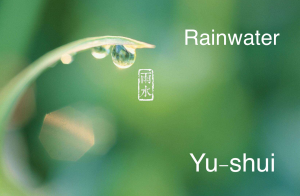
Yu-shui (noun) 雨水(Chinese): Rain water (2nd solar term), literally in Chinese “Yu” 雨 = rain, “shui” 水 = water.
Example:
In the ancient Chinese calendar also known as the “agriculture calendar”, Yu-shui is one of the 24 Chinese solar terms which later spread to many Asian countries. Yu-shui is the 2nd solar term and the second intercalating month (middle). Yu-shui begins when the Sun reaches the celestial longitude of 330° and ends when it reaches the longitude of 345°. Yu-shui more often refers in particular to the day when the Sun is exactly at the celestial longitude of 330°. In the Gregorian calendar, Yu-shui United usually begins around 18 February (19 February East Asia time) and ends around 5 March. Yu-shui indicates that precipitation begins and the rainfall gradually increases. Yu-shui has two layers of meaning. First, the weather is getting warmer and the amount of precipitation is gradually increasing. Second, in the form of precipitation, we are getting less snow, and we are getting more rainfall.
In ancient China, Yu-shui was divided into three periods of 15 days: “In the first period 獭祭鱼, otters began to fish; In the second five days 鸿雁来, geese began to fly back north from the south; during the third-period 草木萌动, fresh buds of trees and flowers began to emerge. Since then, the earth has gradually begun to show a thriving scene.
Natural flowers, trees, birds, and animals all live and move according to a certain season. Their activities are closely related to climate change. Each period 候 in a Jie-qi 节气 is associated with a flower letter wind 花信风. During Yu-shui, the first period is associated with rapeseed flowers 菜花, the second with Chinese bush cherry blossoms 棠棣, third with plum blossoms 李花. In addition to these three flowers, there are cherry blossoms, winter jasmine flowers, Yulan magnolia, and lilac flowers etc that bloom during yu-shui.
Since ancient times, Yu-shui has been a solar term for agricultural purposes in the lunar calendar. Yu-shui is still remembered and celebrated as a Chinese traditional festival.
